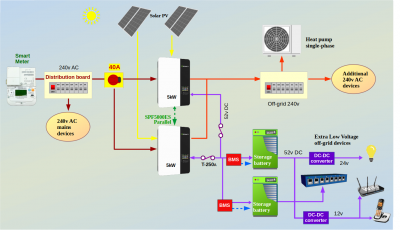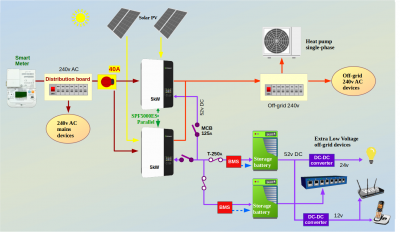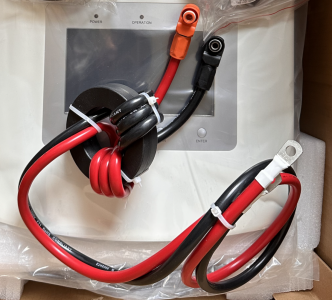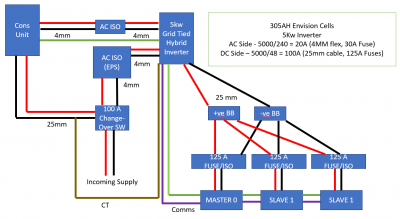You posted that diagram whilst I was writing the above!
Yes, you've got the right idea...
... but the SPF5000ES units in parallel must share the (large) storage battery between them.
You can't have a separate battery for each inverter.
Also you're intending to have a single 2-pole change-over switch for the entire house, rather than one per circuit.
That's fine.
You have to to discuss this with an electrician.
He will need to satisfy himself as to what happens under fault conditions... such as an open-circuit Neutral.
Save energy... recycle electrons!
Save energy... recycle electrons!
Posted by: @transparentWe're probably both drawing diagrams at the same time.
Can I post mine first?
-- Attachment is not available --
Your diagram is also much better than mine! But I think what I am learning (and I am learning a lot) is that by upping my output (in Kw) for the house I am driving price up quite considerably.
I suggest, it would be better (for my bank balance) and easier (in terms of complexity of install) to reduce my inverter requirement to 6Kw. This would enable me to do something like the following:
Do i need the busbars? Voltacon mentioned on the phone that they no longer comply and should be replaced with a DC distribution board.
Rats... I've just amended my diagram to better show the fuses and trips arrangement between inverters and batteries:
There is a 6kW version of the SPF5000ES by Growatt.
It has two solar MPPT inputs instead of one.
But I'm unsure if it's released or certified to UK mains-safety specs.
They did a pre-production run of a few hundred about a year ago.
I'm unsure what Voltacon are referring to by saying that busbars on the DC side are no longer compliant.
Compliant with what?
The whole issue with the sub-75v DC side of the system is that there is no 'standard' in place.
I've been discussing this with a senior engineer at National Grid for a year now.
My view is that we require two regulations:
- a safety-based guidance document for off-grid storage batteries in the home
- a registration with the DNO (that's different to requiring permission)
The first should be ratified by house-insurers so that a safety protocol is in place to prevent fires.
The second will be needed at some point in order to modify our Smart Meter timing to avoid everyone re-charging their batteries from the grid simultaneously.
I need to have a chat with Voltacon myself.
But I'm about to be occupied for the next few hours.
I hope you can cope without more snazzy diagrams in the meantime.
Save energy... recycle electrons!
@transparent Yes no worries. I think, i have decided to go with the grid tied 6Kw inverter option. This, with Brian providing cells and equivalent to the Seplos 280 including BMS.
When you get time, could you provide one of your fantastic diagrams to outline what it needs to look like (assume 3x batteries now as Brian's prices are too good to not take advantage of)?
I'm keen to start ordering the bits and bobs now so want to fully price up each part and if you are happy to continue to advise, confirm i've covered everything off appropriately before taking the plunge.
Should have mentioned that the inverter will likely be this solis: https://www.bimblesolar.com/solis-6k-hybrid-inverter/
Posted by: @makia2023what I am learning (and I am learning a lot) is that by upping my output (in Kw) for the house I am driving price up quite considerably.
Indeed 5kW of grid tied inverter should be enough for most people (you can quote me on it!). The problem with going for (multiple) off-grid inverters is that you need to support all possible house load so you end up oversizing the system which works against the cost saving of using off-grid inverters. Also more boxes mean more things to go wrong (in various, increasing and less tested, combinations); beware cascading failures, odd interactions etc!
Posted by: @makia2023the inverter will likely be this solis
One quick thing to consider is whether you have DNO permission to install the 6kW inverter. Sunsynk inverters do come with G100 approval (provided you update to the correct firmware) whereas Solis does not. G100 can be used to limit the power that goes back to the grid (or is taken from the grid?), which makes it more acceptable to the DNO.
Another thing to watch out for is that if you use Bimble to buy an inverter make sure you know for sure what the precise model number is (which will need to tie up with any G99/G100 application you make). Voltacon do sell some G100 inverters (for a pretty price).
@chickenbig thanks for that. Yeah i am moving from a 5kw solax system which is already DNO registered so will just be updating them. I have already been in contact to confirm I can do so.
6kW will suffice. Just need to confirm the final wiring requirements and parts list then I will take the hit.
Posted by: @makia2023Just need to confirm the final wiring requirements
The Solis S5 looks to use Amphenol Surlok Plus connectors to attach the DC cables onto the inverter. I bought a 5kW version a while ago and it came with 25mm2 cables and an M8 crimp on the other end. I'm not sure whether the 6kW comes with thicker cables... Interestingly the cables were wrapped around an iron core, presumably to reduce high frequency noise.
Ok here we go (having got some extra advice from Bimble as the solis max charge/discharge is 100amps ie 5kw):
Parts list:
48x cells A Grade LF280K Cells (claimed >310AH)
3x battery enclosures with 200amp BMS
3x RJ45 comms cables
CT clamp/cable
3x DC Fused Disconnect 3-pole with NH00 125amp fuses - M8 Fixings (1 pole remains unused)
2x Victron 150 Amp DC BusBar 4 Terminal
TBC Red 25mm 170amp rated DC cable
TBC Black 25mm 170amp rated DC cable
Crimping tool
M8 lugs
Battery side connections
Total price is £6000 (give or take) delivered. That seems like a rather good outcome.
For later (i.e. wont be doing/buying now)
100A changeover switch
1x AC Isolator for EPS function
TBC 4mm 2 + E flex for EPS to board
Note - this will replace existing 5kw HV system so will use same 4mm cable into the consumer unit in addition to existing AC isolators
You will also want a torque wrench and wire cutter capable of cutting 25mm2 cleanly. Do you have a multimeter and a 48v (well, 56v) power supply to perform top balancing with?
Will you be protecting your DC cables in trunking or will you try to get double insulated cable?
Note that your CT clamp and cable will come with the inverter.
Note that according to Bimble Solar the bus-bar comes with M6 terminals ...
I feel you need some form of disconnector (and fuse) between the bus bar and inverter. That should not cost so much now that you are in the NH00 world.
Note that for the NH00 fuses, I had problems finding out whether the Jean Mueller fuses are DC rated (they sort of are, but only if you can find the right document ... the data-sheet does not mention the DC rating, confusingly). Their fuse-holders explicitly are DC rated. I chose to use Mersen NH00 fuses which state their DC rating on the data-sheet, and these can be found at Bimble Solar.
And please don't forget the heatshrink for the lugs!
Posted by: @chickenbigYou will also want a torque wrench and wire cutter capable of cutting 25mm2 cleanly. Do you have a multimeter and a 48v (well, 56v) power supply to perform top balancing with?
Will you be protecting your DC cables in trunking or will you try to get double insulated cable?
Note that your CT clamp and cable will come with the inverter.
Note that according to Bimble Solar the bus-bar comes with M6 terminals ...
I feel you need some form of disconnector (and fuse) between the bus bar and inverter. That should not cost so much now that you are in the NH00 world.
Note that for the NH00 fuses, I had problems finding out whether the Jean Mueller fuses are DC rated (they sort of are, but only if you can find the right document ... the data-sheet does not mention the DC rating, confusingly). Their fuse-holders explicitly are DC rated. I chose to use Mersen NH00 fuses which state their DC rating on the data-sheet, and these can be found at Bimble Solar.
And please don't forget the heatshrink for the lugs!
Yep got it - trunking will be used for added protection regardless. I also have a good multimeter, wire cutter and a torque wrench. CT Clamp i will reuse my existing as it is already run (approx 12m) in external trunking to the consumer unit. I will buy M6 and M8 connectors to be safe.
If each battery is fuse protected then why do I need another fuse between busbar and inverter? Isnt it overkill? Although I acknowledge a DC switch would be good. Any recommendations?
For fuses i'm going with the Merson NH00.
And heatshrink i have orderd.
I have surge protection on the main consumer unit so is this sufficient to cover the inverter? Or should i put another independent protector between inverter and consumer unit?
- 26 Forums
- 2,364 Topics
- 53.6 K Posts
- 568 Online
- 6,029 Members
Join Us!
Worth Watching
Latest Posts
-
RE: Octopus Cosy Heat Pump Owners & Discussion Thread
TRV heads do indeed close completely once room temp is ...
By JamesPa , 2 minutes ago
-
RE: Ecodan unable to hit legionella target temp - what's the consensus?
UPDATE: Thanks everyone who commened with suggestions h...
By 9jwr9 , 8 minutes ago
-
-
RE: ASHP sizing - value of Heat Transfer Coefficient
@toodles Hi, my friend recently made a video about heat...
By HeatPumpMe , 23 hours ago
-

How long will your energy contract last?
Some heat pump tariffs don’t run as long as a heat pu...
By Toodles , 2 days ago
-

@morgan They are unsupervised these days, can’t get the...
By Toodles , 2 days ago
-
-

RE: Setback savings - fact or fiction?
Exactly. We only need to compare conditions, to decide ...
By cathodeRay , 3 days ago
-
RE: Balancing financial efficiency and comfort using the Octopus Cosy tariff
I found because I have very low heat loss I can set bac...
By RadWhisperer , 3 days ago
-
RE: Need Help Optimising My Rushed ECO4 Install: 12kW Bosch Heat Pump
Welcome @mickamills We too have an oversized 12kW Sa...
By Old_Scientist , 3 days ago
-
RE: My Powerwall 3 Consumes 3-4 kWh/Day in Self-Consumption: Is This Normal?
@caron I can confirm that the power usage of the PW3 is...
By Old_Scientist , 3 days ago
-
RE: Speedcomfort radiator fans
Thats true, but having tried (and succeeded) in constru...
By JamesPa , 4 days ago
-
RE: Solis S6-EH1P8K-L-PLUS – Why I Chose It and What I’ve Learned So Far
@bash brilliant, thanks for the feedback
By energy9165 , 4 days ago
-

RE: Heat Pump Heats the House… But It’s Not Cosy. Emitter Changes or System Tweak?
@alastair There I was, feeling grumpy, he said “Cheer u...
By Toodles , 4 days ago
-
RE: Grant Aerona: Is there a setting to keep the 2-port valve open during pump blockade
Depends on OAT. Mine cycles at OAT>10 and of course...
By JamesPa , 4 days ago
-
RE: New Fogstar 15.5kWh upright solution
@transparent My conclusion is as you have noted, tha...
By Bash , 4 days ago
-
RE: Mitsubishi Ecodan R290 10kW performance
And to you too. Wishing you a very enjoyable festive s...
By Sheriff Fatman , 4 days ago
-

RE: External pipework insulation
They do? But that isn't apparent from the photos we'r...
By Transparent , 4 days ago
-

RE: Say hello and introduce yourself
@velcro welcome to the forums. Please feel free start a...
By Mars , 5 days ago
-
Daikin EDLA11D3V3 DHW Settings
I have a newly installed EDLA11D3V3 which I'm still get...
By Velcro , 5 days ago








